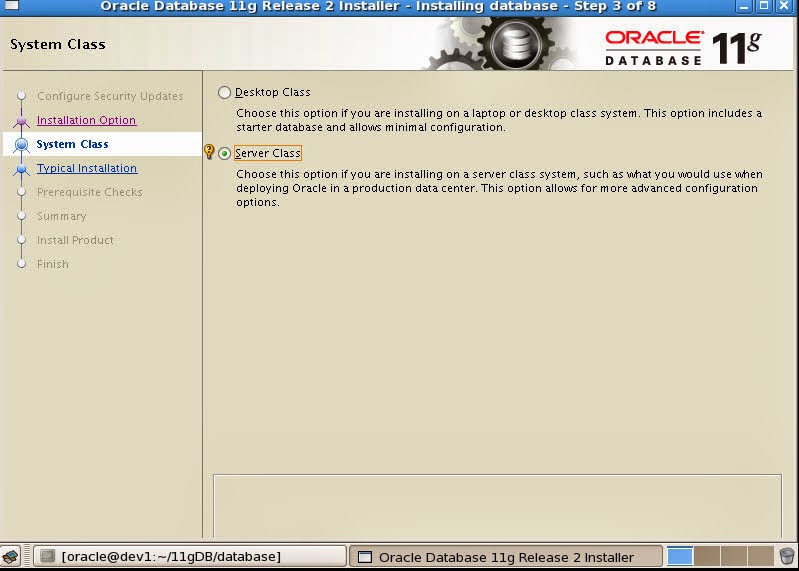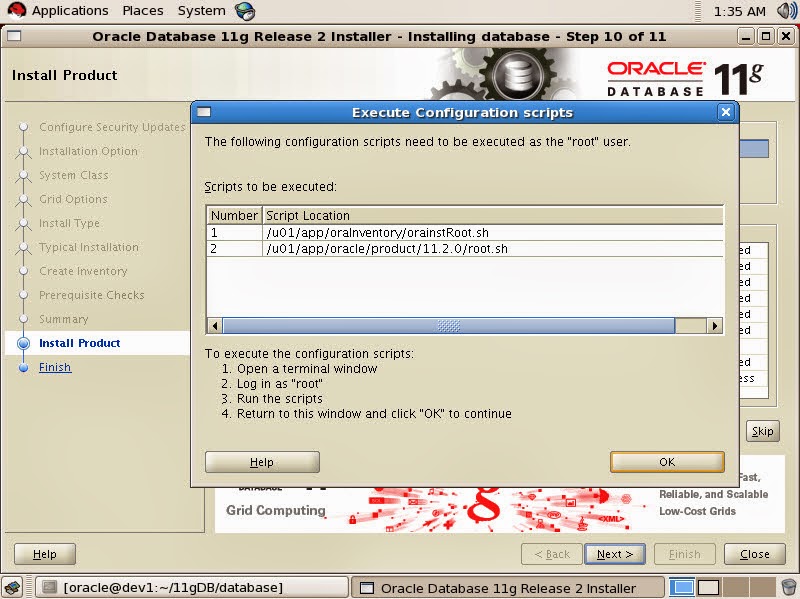Linux Operating system installation.
Kindly refer my previous post to
install Linux 64 bit using Vmware.
System Requirements check :
- We need Minimum 1gb of ram memory for the Linux
machine.
- The swap space should be Minimum 1.5 times the ram
size(for ram size b/n 1gb to 2 gb).
- The /tmp mount should have Minimum 1gb of space
available.
- Check the free space of the mount points where we are
installing oracle software and the database files.
- Check the Linux kernel version, the kernel version for
installing oracle 11gR2 should be equal to or greater
than 2.6.18.
Command to check linux kernel version
[root@dev1 ~]# uname -r
2.6.18-128.el5
[root@dev1 ~]#
Prerequisites
for installing oracle software.
·
Add an
entry of ip address,fully qualified name and machine name in /etc/hosts
[root@dev1 ~]# cat /etc/hosts
# Do not remove the following line, or various programs
# that require network functionality will fail.
192.168.152.131 dev1.localdomain.com dev1
127.0.0.1
localhost.localdomain localhost
::1
localhost6.localdomain6 localhost6
[root@dev1 ~]#
·
Add the
following lines in /etc/sysctl.conf
Some entries may already existing in
this linux kernel configuration file. If the given value is greater than the
existing value for any parameter, we have to adjust it to the greater value
otherwise we can ignore it.
# Oracle settings
fs.aio-max-nr = 1048576
fs.file-max = 6815744
kernel.shmall = 2097152
kernel.shmmax = 536870912
kernel.shmmni = 4096
kernel.sem = 250 32000 100 128
net.ipv4.ip_local_port_range = 9000 65500
net.core.rmem_default = 262144
net.core.rmem_max = 4194304
net.core.wmem_default = 262144
net.core.wmem_max = 1048586
net.ipv4.tcp_wmem = 262144 262144 262144
net.ipv4.tcp_rmem = 4194304 4194304 4194304
To make effect the kernel parameters
changes immediately
[root@dev1 ~]# sysctl –p
·
Create OS
user (oracle software owner) and groups needed to install oracle software.
[root@dev1 ~]# groupadd dba
[root@dev1 ~]# groupadd oinstall
[root@dev1 ~]# groupadd oper
[root@dev1 ~]# useradd -g oinstall
-G dba,oper oracle
[root@dev1 ~]# passwd oracle
Changing password for user oracle.
New UNIX password:
BAD PASSWORD: it is based on a
dictionary word
Retype new UNIX password:
passwd: all authentication tokens
updated successfully.
[root@dev1 ~]#
·
Create a
directory where oracle software will be installed and provide the necessary
ownership and privileges.
[root@ dev1 ~]# mkdir -p
/u01/app/oracle/product/11.2.0/db_1
[root@ dev1~]# chown -R oracle:oinstall /u01
[root@ dev1~]# chmod -R 775 /u01
[root@ dev1~]#
·
Set the
shell limits in /etc/security/limits.conf for the oracle owner
oracle
soft nproc 2047
oracle
hard nproc 16384
oracle
soft nofile 1024
oracle
hard nofile 65536
·
Add the
following line to /etc/pam.d/login if the same is not there
session required
pam_limits.so
·
Check the
/etc/selinux/config to see whether the selinux parameter is disabled.
SELINUX=disabled
·
Verify
that the required rpm packages are installed for oracle
Mount the RHEL5 dvd go
to /media/RHEL_5.7 i386 DVD/Server directory and give the below commands.
By using "rpm -Uvh <package name>" command, the packages will
be installed if it is not previously installed
rpm -Uvh binutils-2*
rpm -Uvh compat-libstdc++-33*
rpm -Uvh elfutils-libelf-0*
rpm -Uvh elfutils-libelf-devel-0*
rpm -Uvh
elfutils-libelf-devel-static-0*
rpm -Uvh gcc-4*
rpm -Uvh gcc-c++-4*
rpm -Uvh glibc-2*`uname -p`*
rpm -Uvh glibc-common-2*
rpm -Uvh glibc-devel-2*
rpm -Uvh glibc-headers-2*
rpm -Uvh kernel-headers-2*
rpm -Uvh ksh-20*
rpm -Uvh libaio-0*
rpm -Uvh libaio-devel-0*
rpm -Uvh libgcc-4*
rpm -Uvh libgomp-4*
rpm -Uvh libstdc++-4*
rpm -Uvh libstdc++-devel-4*
rpm -Uvh make-3*
rpm -Uvh numactl-devel-0*
rpm -Uvh sysstat-7*
rpm -Uvh unixODBC-2*
rpm -Uvh unixODBC-devel-2*
rpm -Uvh compat-libstdc++-33*
·
Add the
following lines to .bash_profile file.
switch to oracle user and add the
following entries.
# Oracle settings
TMP=/tmp; export TMP
TMPDIR=$TMP; export TMPDIR
ORACLE_HOSTNAME=dev1.localdomain.com;
export ORACLE_HOSTNAME
ORACLE_BASE=/u01/app/oracle; export
ORACLE_BASE
ORACLE_HOME=$ORACLE_BASE/product/11.2.0/db_1;
export ORACLE_HOME
ORACLE_SID=ora11g; export ORACLE_SID
ORACLE_TERM=xterm; export
ORACLE_TERM
PATH=$ORACLE_HOME/bin:/usr/sbin:$PATH;
export PATH
LD_LIBRARY_PATH=$ORACLE_HOME/lib:/lib:/usr/lib;
export LD_LIBRARY_PATH
CLASSPATH=$ORACLE_HOME/JRE:$ORACLE_HOME/jlib:$ORACLE_HOME/rdbms/jlib;
export CLASSPATH
if [ $USER = "oracle" ];
then
if [ $SHELL =
"/bin/ksh" ]; then
ulimit -p 16384
ulimit -n 65536
else
ulimit -u 16384
-n 65536
fi
fi
·
Run the
following command to make the given changes effective.
[oracle@dev1 ~]$ source
~/.bash_profile
[oracle@dev1 ~]$
·
Install
the oracle software and create a database using DBCA.
Now the system is ready to install
oracle software.
Login as oracle user, download/copy the oracle 11gR2 software and unzip the
media file.A folder named "database" will be created, go to the database
folder and execute the "runInstaller" script to start oracle
universal installer.
[oracle@dev1 database]$ ll
total 36
drwxr-xr-x 12 oracle oinstall
4096 Mar 28 13:22 doc
drwxr-xr-x 4 oracle oinstall 4096 Mar 28 13:22 install
drwxr-xr-x 2 oracle oinstall 4096 Mar 28 13:22 response
drwxr-xr-x 2 oracle oinstall 4096 Mar 28 13:22 rpm
-rwxr-xr-x 1 oracle oinstall 3226 Mar 28 13:22
runInstaller
drwxr-xr-x 2 oracle oinstall 4096 Mar 28 13:22 sshsetup
drwxr-xr-x 14 oracle oinstall
4096 Mar 28 13:26 stage
-rwxr-xr-x 1 oracle oinstall 5402 Mar 28 13:26
welcome.html
Please follow the screenshot for database installation.
Your database installation is complete.
[oracle@dev1 database]$ sqlplus "/as sysdba"
SQL*Plus: Release 11.2.0.1.0 Production on Fri Mar 28 17:50:15 2014
Copyright (c) 1982, 2009, Oracle. All rights reserved.
Connected to:
Oracle Database 11g Enterprise Edition Release 11.2.0.1.0 - 64bit Production
With the Partitioning, OLAP, Data Mining and Real Application Testing options
SQL> select instance_name,version from v$instance;
INSTANCE_NAME VERSION
---------------- -----------------
ora11g 11.2.0.1.0
SQL>












































